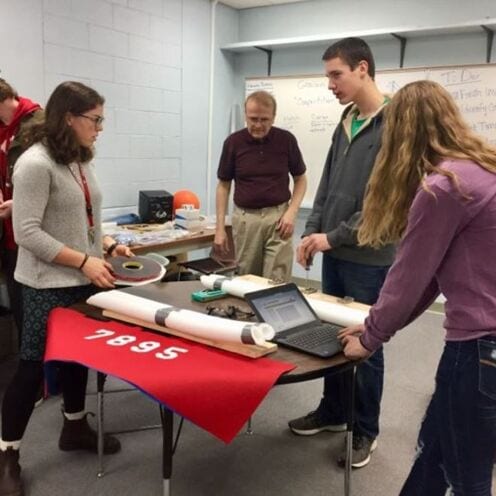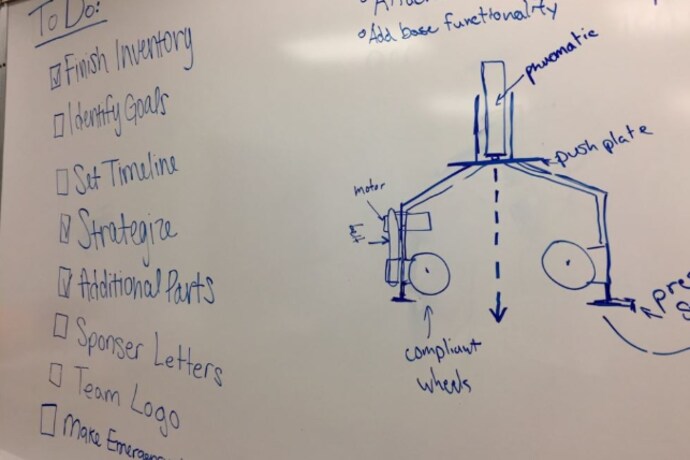
What It Takes to Launch a Robotics Team in a Rural Community
Liddy Renner (Idaho '18) worked with students to create Homedale High School’s first robotics team, proving to her students that anyone, anywhere, can be a scientist.
Liddy Renner is a first-year corps member teaching 9th Grade Science and Health at Homedale High School in Homedale, Idaho. Liddy’s classroom vision includes encouraging all students to think critically and stresses her belief that every single one of her students–that everyone, anywhere–can be a scientist.
Renner was approached by students who wanted to start a robotics team after hearing about the FIRST (For Inspiration and Recognition of Science and Technology)® Robotics program. According to the FIRST® Robotics website, the program’s mission is to, “inspire young people to be science and technology leaders and innovators, by engaging them in exciting mentor-based programs that build science, engineering, and technology skills, that inspire innovation, and that foster well-rounded life capabilities including self-confidence, communication, and leadership.”
“Being able to work with students through a STEM program such as FIRST® Robotics is an exciting extension of the time my students and I spend together in the classroom," Renner says. "Students are getting hands-on experience in design, engineering, mechanics, and computer programming as they work together to build a robot."
Renner and another teacher were able to secure two grants to fund this team in just a short amount of time.
The grants, one through the Idaho STEM Action Committee which is funded by the Laura Moore Cunningham Foundation, and the second from FIRST® Robotics for first-year rookie teams, enabled the team to enter the competition. The steep cost of entry–$6,000–was an immediate barrier. The two grants covered the team’s entry fee and kit of parts, which included many of the technical pieces needed to build a robot like motors, a computer, cameras, etc.
We are extremely grateful to have received the grants; without them our participation in the competition, and our students getting this hands-on experience, would not be possible," Renner says. "We applied for the grants in early December, and by the first week of January we were ready to roll!”

Renner is one of two mentors/coaches for the team who both consider themselves to be learning right along with the kids. The other mentor of the program, Mark Thatcher, teaches science at Homedale High School. The two teachers work with the team every afternoon and during the day on Fridays. Homedale has a 4-day school week, which means teachers and students spend their days off working together on the project. Right now they have 6-12 kids who have actively been a part of the build season.
"Our goals for this season are to build a working robot, and successfully embody the ideals of the competition–gracious professionalism and ‘coopertition’–which both encourage sportsmanship and deep thinking. We are looking forward to the build season next year to deepen our knowledge, and are looking at creating a robotics elective class for the 2019-2020 school year," Renner says. "Homedale has great, hands-on mechanics opportunities, and a robotics elective class would allow students to build on those foundational skills and become successful in the fields of engineering, robotics and computer programming beyond their time at Homedale High.”
“It's been really special to see the growth and effort put forth by our students as they've approached the very steep learning curve that comes along with building and engineering a robot from scratch," Renner says. "Many teams have been competing and building for over 15 years, and have significant funds and resources to support their robotics programs."
She adds, "This is something we will need to work through for next year, as the grants we received were specific to first-year, rural teams.”
Renner notes that opportunities such as this one are oftentimes hard to come by in rural communities like Homedale, especially when technology is not as immediately accessible as in more urban areas.
“Over 50% of my students do not have computers or internet at home, so providing a space for them to push beyond their original limitations has been incredibly inspiring," Renner says. "I am incredibly proud of their growth and and dedication to this project, and can’t wait to see the final product in just a few short weeks!”
The Homedale Trobots will compete with other robotic teams at Boise State University on March 28-30th. Check out more photos of the team.
Sign up to receive articles like this in your inbox!
Thanks for signing up!
Content is loading...







